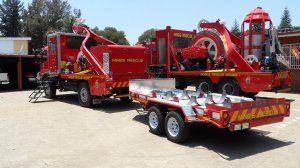Rescue organisation launches drill rescue unit for collieries


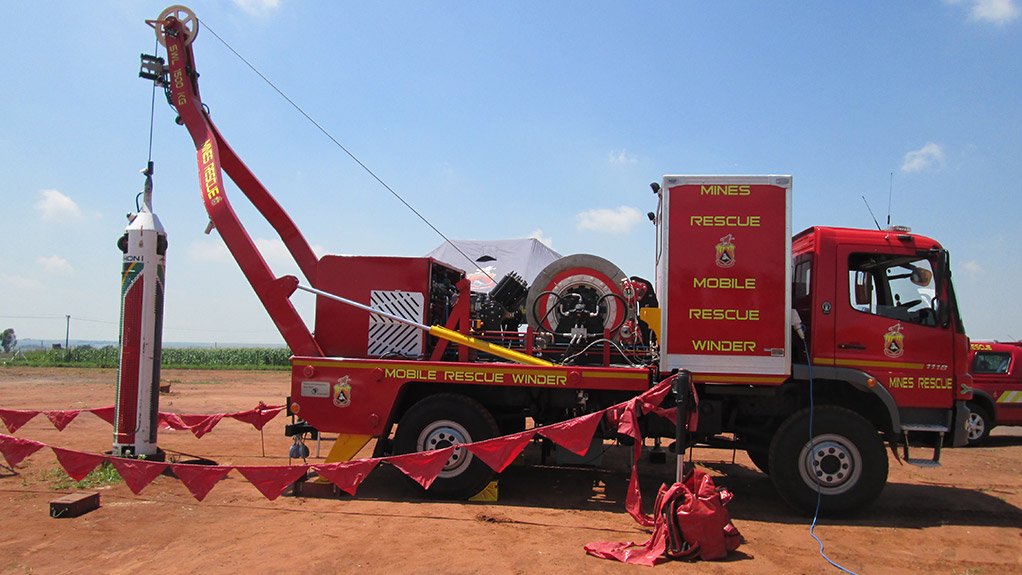


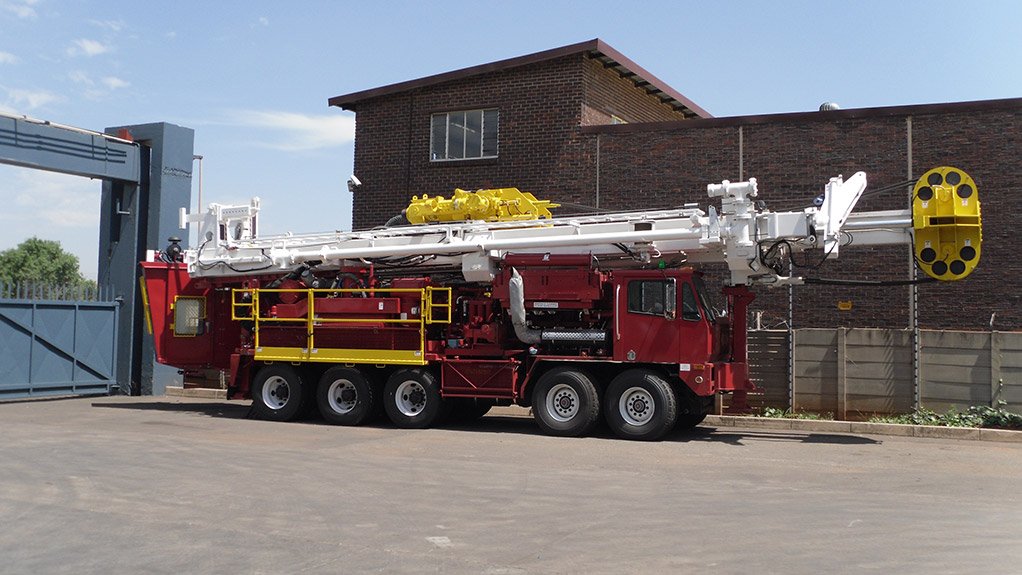
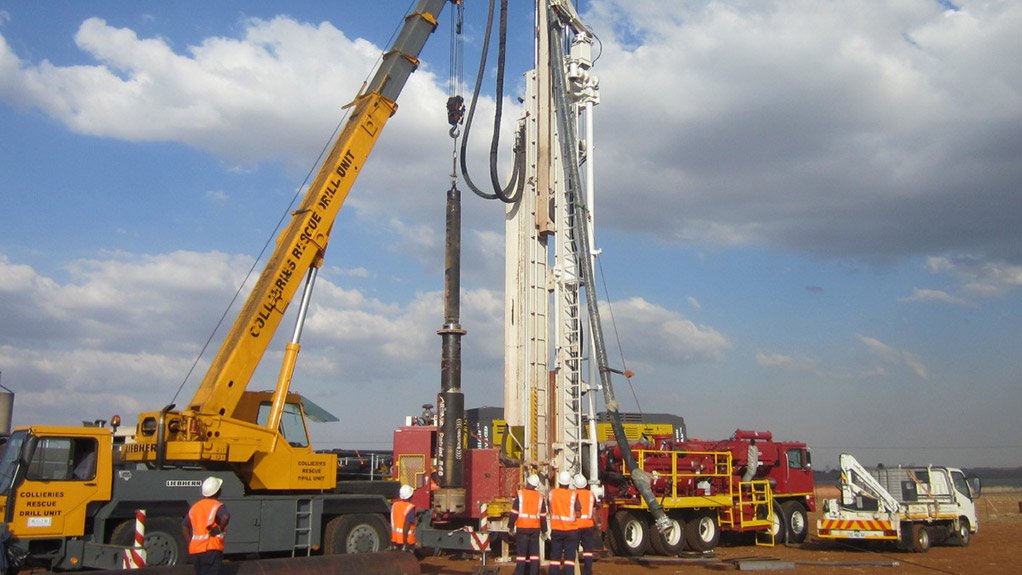
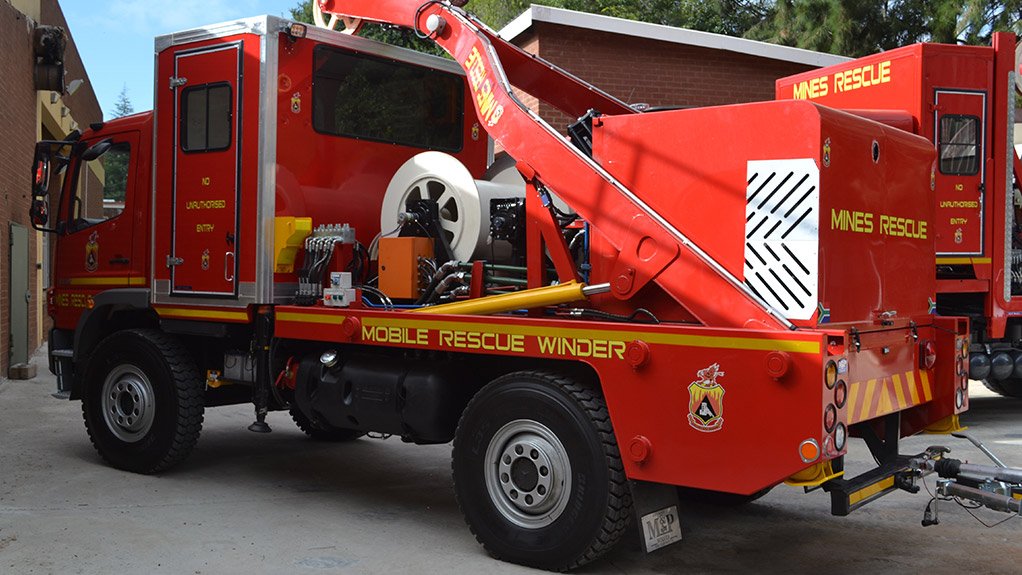
SAFE DELIVERY Representatives from Mines Rescue Services South Africa, the Department of Mineral Resources and the Chamber of Mines’ Collieries Committee welcome Goedehoop assistant mine manager Lebo Mpasha back after a simulated rescue at Goedehoop colliery
RESCUE WINDER The winder is fully hydraulic with a maximum lift capacity of 1.5 t and operates at 0.5 m per second
ALWAYS ON CALL The Collieries Committee arranged for the manufacture of a new rescue winder and rescue capsule with a trailer for the capsule
READY FOR ACTION The mobile rescue winder is mounted on a Mercedes-Benz-manufactured truck platform and uses 1 300 m of 13-mm-thick non-spin rope to lower and lift the rescue capsule
RESCUE DRILLING The Chamber of Mines Collieries Committee agreed to provide funds for the purchase of the Schramm T130XD
DRILL TESTS The first operation of the drill was undertaken at Goedehoop colliery to train brigadesmen and rescue winder crews, in October, last year
ON STANDBY Mines Rescue Services South Africa rescue winders and capsule for the rescuing of trapped miners
Mining-focused rescue organisation Mines Rescue Services of South Africa (MRSSA) last month launched a new rescue drill unit for the retrieval of trapped coal miners.
The first operation of the drill was undertaken in October last year, at diversified mining major Anglo American’s Goedehoop colliery, in Middelburg, Mpumalanga, to train brigadesmen and rescue winder crews.
Several problems were initially encountered, including the clay overburden blocking the reverse circulation (RC) of the drill, flooding of the test site owing to the addition of water to clear the system, and rod changes that took longer than expected.
Nevertheless, an inclined hole was drilled in November and, during January and February, the rescue winder and capsule were successfully tested in the vertical hole.
Product History
The new US-manufactured Schramm drill and its ancillary equipment replaces the outdated Ingersoll-Rand T4 and T5 drill machines that were previously commissioned for rescue operations at collieries.
In 2009, MRSSA decided to investigate possible modifications and upgrades to the Ingersoll-Rand-manufactured equipment to ensure the safe and reliable operation of the rescue drill and related equipment.
The investigation revealed serious shortcomings in the former models, which impacted negatively on the drill’s safety.
In addition, the reliability of the equipment for rescue operations was found to be lacking. Owing to Ingersoll-Rand no longer manufacturing drilling equipment, there was no prospect of upgrading the old drilling machines.
Approval Process
Consequently, South Africa’s Chamber of Mines’ (CoM’s) Collieries Committee convened a task team in May 2010 – comprising representatives from mining houses, the CoM, MRSSA and the eMalahleni-based Colliery Training College – to investigate the feasibility of new rescue drilling equipment.
The CoM’s concerns were affirmed when, in June 2011, the outdated rescue drill was deployed to drill two 100-m-deep holes at an underground colliery. Although the holes were eventually drilled, several equipment failures occurred during opeation.
The task team also found that the rescue capsule – used to transport miners to the surface – and the winder – a winch used to lower and lift the rescue capsule – were obsolete and not suitable for rescue work, owing to the prevailing legal and technical environment.
The task team subsequently investigated several options to replace the T4 and T5 drills, which led them to two replace- ment options, the Swedish indus- trial company Atlas Copco’s Predator and the US drill manufacturer Schramm’s T130XD drills.
The task team visited both drill manufacturing plants in the US, where the competing manufacturers presented the respective models in September 2011.
Subsequently, the MRSSA prepared a detailed comparison of the two models on offer and submitted their findings to the task team.
MRSSA reports that Schramm’s product outperformed Atlas Copco’s unit in terms of its standard safety features, as well as its ability to be transported by road with no special permits or escort vehicles needed, while Atlas Copco’s unit cost less and had a better maintenance solution through a local supplier.
Having finalised its decision, the Collieries Committee agreed to provide MRSSA with the funds to buy the Schramm T130XD drill and the Schramm T685WS drill with ancillary equipment. The cost was borne by the Chamber’s coal-producing members who operated underground collieries.
The total cost of the acquisition of both drills and ancillary equipment amounted to just under R66-million.
The Collieries Committee also agreed to provide additional funds for the manufacture of a new rescue winder and rescue capsule, with a trailer for the capsule and a storage facility, which amounted to a total of R3.4-million.
These financial contributions were determined according to the staff complement at the respective mines’ underground operations.
Further, the task team recommended to the Collieries Committee that the Schramm T130XD drill replace the T5 drill, and that the Schramm T685WS drill replace the T4 pilot drill.
The Schramm T130XD drill arrived in the country in September 2012 and was transported to the site of truck body manufacturer TFM Industries in Olifantsfontein for confirmation that the drill met South African vehicle specifications.
Owing to the submission of incorrect design information, the drill modifications were delayed until July last year.
Technical Overview
The Schramm T130XD drill has a pullback capacity of 59 t. Its mast rises to a height of 15.24 m, while its 711 mm casing advance system houses a Numa Superjaws drill bit.
The standard hole-diameter uses a 660 mm Numa RC-210 hammer-bit.
Three Atlas Copco XRVS617 compressors provide an output of 26.36 m3 at a pressure of 25 bar, while booster pressure is pro- vided by an Atlas Copco compressor with an output of 145.44 m3 at a pressure of 69 bar.
Moreover, a Schramm load safe system with automated pipe handler lifts rods onto the drill with a hydraulic on/off of pipe to rack.
Meanwhile, the Schramm T685WS drill has a pullback force of 42.5 t, while its mast rises 9.144 m high.
Its standard hole-diameter is 165 mm and uses RC technology.
The mobile rescue winder is mounted on a Mercedes-Benz-manufactured truck platform and uses 1 300 m of 13-mm-thick nonspin rope to lower and lift the rescue capsule.
The winder is operated by a fully hydraulic winch with a maximum lift capacity of 1.5 t; it operates at 0.5 m/s and is backed up by a four-cylinder Perkins engine.
The rescue capsule weighs 600 kg.
Fire Suppression
In addition to the rescue drill unit, a fire suppression system that uses gas-inertisation also complements MRSSA’s range of rescue equipment.
MRSSA realised in 2007 that it had no immediate access to any fire inertisation equipment to extinguish large colliery fires. In the same year, the CoM’s Collieries Committee agreed to provide R22-million for an air-liquid inertisation system, a diesel-powered generator and gas chromatography equipment.
The entire unit is trailer-mounted, making it transportable by road to any location in the country.
The system will be used after a pilot drill has drilled holes into the burning workings of a colliery and will then inject the inert gas through these holes.
Comments
Press Office
Announcements
What's On
Subscribe to improve your user experience...
Option 1 (equivalent of R125 a month):
Receive a weekly copy of Creamer Media's Engineering News & Mining Weekly magazine
(print copy for those in South Africa and e-magazine for those outside of South Africa)
Receive daily email newsletters
Access to full search results
Access archive of magazine back copies
Access to Projects in Progress
Access to ONE Research Report of your choice in PDF format
Option 2 (equivalent of R375 a month):
All benefits from Option 1
PLUS
Access to Creamer Media's Research Channel Africa for ALL Research Reports, in PDF format, on various industrial and mining sectors
including Electricity; Water; Energy Transition; Hydrogen; Roads, Rail and Ports; Coal; Gold; Platinum; Battery Metals; etc.
Already a subscriber?
Forgotten your password?
Receive weekly copy of Creamer Media's Engineering News & Mining Weekly magazine (print copy for those in South Africa and e-magazine for those outside of South Africa)
➕
Recieve daily email newsletters
➕
Access to full search results
➕
Access archive of magazine back copies
➕
Access to Projects in Progress
➕
Access to ONE Research Report of your choice in PDF format
RESEARCH CHANNEL AFRICA
R4500 (equivalent of R375 a month)
SUBSCRIBEAll benefits from Option 1
➕
Access to Creamer Media's Research Channel Africa for ALL Research Reports on various industrial and mining sectors, in PDF format, including on:
Electricity
➕
Water
➕
Energy Transition
➕
Hydrogen
➕
Roads, Rail and Ports
➕
Coal
➕
Gold
➕
Platinum
➕
Battery Metals
➕
etc.
Receive all benefits from Option 1 or Option 2 delivered to numerous people at your company
➕
Multiple User names and Passwords for simultaneous log-ins
➕
Intranet integration access to all in your organisation




